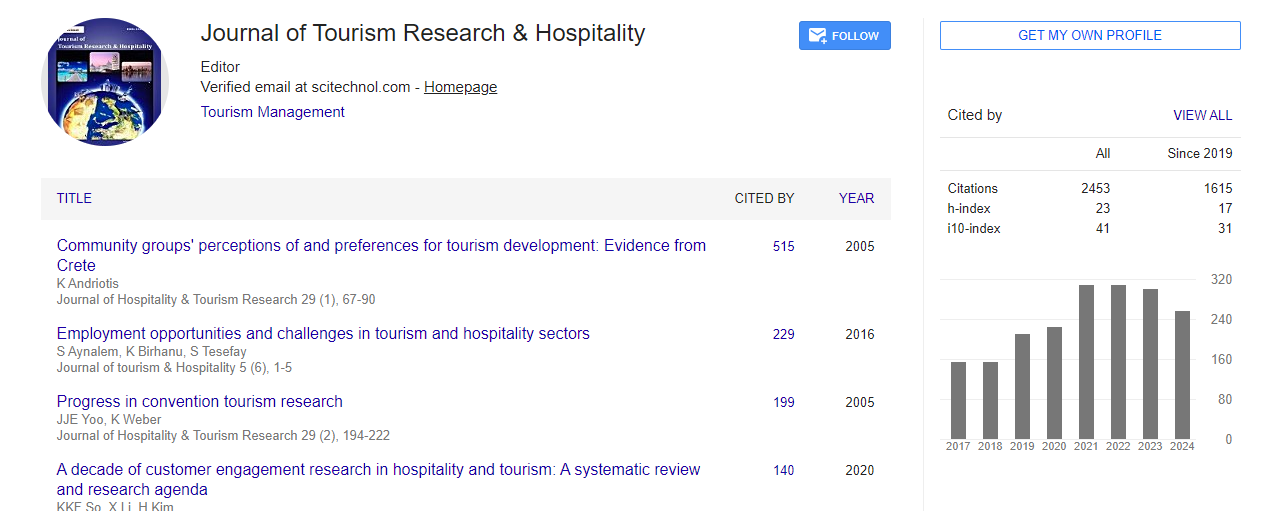Commentary, J Tourism Res Hospitality Vol: 13 Issue: 3
Balancing the Scales: Strategies for Mitigating Overtourism
Xiaoxiao Fu*
1Department of Tourism Marketing, Purdue University, Purdue, United States of America
*Corresponding Author: Xiaoxiao Fu,
Department of Tourism Marketing, Purdue
University, Purdue, United States of America
E-mail: xiaofu@gmail.com
Received date: 24 May, 2024, Manuscript No. JTRH-24-143396;
Editor assigned date: 27 May, 2024, PreQC No. JTRH-24-143396 (PQ);
Reviewed date: 14 June, 2024, QC No. JTRH-24-143396;
Revised date: 21 June, 2024, Manuscript No. JTRH-24-143396 (R);
Published date: 28 June, 2024, DOI: 10.4172/2324-9110.1000188.
Citation: Fu X (2024) Balancing the Scales: Strategies for Mitigating Overtourism. J Tourism Res Hospitality 13:3.
Description
Overtourism has become a pressing issue in the travel and tourism industry, characterized by the negative impacts of excessive visitor numbers on destinations, local communities, and the environment. While tourism is a significant economic driver and cultural exchange medium, overtourism represents the darker side of its expansion. This study tells the phenomenon of overtourism, its causes, effects, and potential solutions. Overtourism refers to a situation where a destination experiences more tourists than it can sustainably accommodate. This excessive influx can overwhelm local infrastructure, degrade natural and cultural resources, and lead to a diminished quality of life for residents. The concept extends beyond simple overcrowding to encompass broader issues such as environmental degradation, cultural erosion, and economic imbalance.
Historically, tourism has evolved from elite leisure travel to mass tourism, driven by increased disposable incomes, technological advancements in transportation, and the democratization of travel. The concept of overtourism began to gain attraction as popular destinations faced unprecedented visitor numbers. Landmark events like the rise of budget airlines, social media-driven travel trends, and global economic growth contributed to the acceleration of overtourism.
Causes of overtourism
The expansion of low-cost airlines and the rise of online booking platforms have made travel more accessible and affordable. This has led to a surge in the number of travelers, particularly to popular destinations that offer budget-friendly options. Increased accessibility often results in a disproportionate concentration of tourists in certain areas. Social media platforms and travel influencers play a significant role in promoting destinations and experiences. Viral posts and endorsements can lead to sudden spikes in visitor numbers, as travelers flock to locations featured in popular content. While this can boost local economies, it can also strain resources and lead to overtourism. Many destinations, particularly in developing countries, rely heavily on tourism as a primary source of income. This economic dependence can drive aggressive marketing and promotion strategies, leading to an unsustainable increase in visitor numbers. The pressure to attract more tourists can overshadow the need for sustainable management practices. Excessive tourist numbers can deplete local natural resources such as water, forests, and wildlife. For instance, popular hiking trails and beaches may suffer from erosion and littering due to high foot traffic. Increased tourism can lead to higher levels of pollution, including air, water, and noise pollution.
Tourist activities, transportation, and waste generation contribute to the environmental footprint of destinations. Development to accommodate tourists, such as building new hotels and resorts, can lead to the destruction of natural habitats and biodiversity loss. The commercialization of local cultures to cater to tourists can lead to the dilution of traditional practices and values. In some cases, local communities may be displaced to make way for tourism infrastructure. This can lead to the erosion of cultural heritage and disrupt traditional ways of life. The commodification of cultural practices and traditions for tourist consumption can undermine their significance and reduce them to mere attractions. The influx of tourists can drive up the cost of living for local residents, particularly in popular destinations. Increased demand for goods and services can lead to higher prices, making it difficult for locals to afford basic necessities. Destinations heavily reliant on tourism may face economic instability.
Sustainable tourism practices
Implementing strategies to manage visitor numbers and distribute tourist flows can help mitigate the impacts of overtourism. Promoting sustainable practices such as reducing waste, conserving water, and protecting natural habitats is essential. Destinations can work with local communities and businesses to adopt eco-friendly practices and minimize their environmental footprints. Community-based tourism initiatives can empower residents and provide them with a stake in managing tourism impacts. Encouraging economic diversification beyond tourism can reduce dependence on the industry and enhance local resilience. Supporting other sectors such as agriculture, technology, and crafts can make a more balanced economy. Developing and enforcing policies and regulations to manage tourism impacts is essential. This includes establishing guidelines for sustainable development, monitoring visitor numbers, and ensuring compliance with environmental and cultural standards. Implementing tourism taxes and fees can help fund infrastructure improvements, conservation efforts, and community development projects. These funds can be used to mitigate the negative impacts of tourism and support local initiatives. Collaboration between governments, tourism operators, local communities, and non-governmental organizations can lead to more effective solutions. Partnerships can facilitate the sharing of resources, knowledge, and best practices for managing tourism.
Conclusion
Overtourism represents a complex and multifaceted challenge that requires a comprehensive approach to address its causes and effects. While tourism offers significant economic, cultural, and social benefits, it also poses risks to destinations if not managed responsibly. By implementing sustainable practices, engaging local communities, and enforcing effective policies, destinations can work towards mitigating the negative impacts of overtourism and ensuring a balanced and harmonious relationship between tourists and host communities.
 Spanish
Spanish  Chinese
Chinese  Russian
Russian  German
German  French
French  Japanese
Japanese  Portuguese
Portuguese  Hindi
Hindi 

